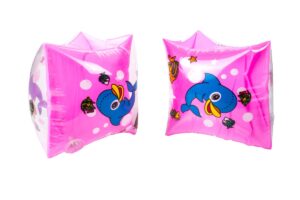
Before starting swimming lessons with us, we often have parents tell us their children are great swimmers. With water wings or other “floaties,” that is. This is why they are usually shocked to find out why children should not use water wings.
Being safe in the water takes knowledge and understanding. Whether you’re hitting the beach, boating, heading to a water park or neighbourhood pool party, safety should be kept in mind. The good news is there are alternatives to water wings. Below are some of the reasons to avoid water wings.
Hinder Maneuverability
Once water wings are blown up and placed on the upper part of each arm, children’s heads can stay above water. This is only the case if the child is upright or vertically positioned. The shape, size and placement of water wings makes it hard for children to move in the water. If a child rolls over and ends up face down in the water, it can be harder to turn back over.
The vertical position also teaches children that this is the right way to swim. This is a habit that’s hard to break when it’s time to swim without help. Swimming vertically is harder. It also makes it more difficult to teach children to put their faces in the water when it’s time to swim unassisted.
They Can Deflate, Shift or Slip Off
Water wings help children keep their heads above the water. However, they can easily come off their arms. They also have the possibilities of shifting positions and losing air. This can give a child a scare in the water.
To avoid these problems, it’s important to supervise your child in the pool. Young children should be within arm’s reach at all times. Water wings do not serve as a substitute for a lifejacket. This should always be kept in mind.
Provide Buoyancy in the Wrong Place
Water wings were designed for fun times in the water. Because they only make the arms float, your child’s full body is not supported. This causes children to try and balance themselves in water the wrong way. Water wings teach children to swim in a vertical position.
Using water wings can slow your child’s learning down. This is mainly because they will need to unlearn the dependency they have on water wings. When it comes to balancing and floating, a different approach needs to be taken. Children have to use their torso and breath control to float rather than their arms.
Not an Approved Buoyancy Device
Water wings do not prevent downing and are not a lifesaving device. This is something that most people do not know. They can prevent a false sense of security. In the United States, the Coast Guard regulates life jackets and other flotation devices. According to the Coast Guard, there are five different categories of personal floatation devices (PFDs):
- Off-Shore Life Jacket: Works in all types of water and is ideal for long waits for rescues.
- Near-Shore Buoyancy: Good for calm water where help is readily available.
- Flotation Aid: Helpful in inland waters when rescuers are close by.
- Throwable Devices (Cushions or Rings): Wear when being directly supervised.
- Special Use Devices (Float Coats or Deck Suits): Use when doing certain activities such as working in cold conditions.
In Canada, life jackets and other floatation devices are regulated by the Ministry of Transportation. Transport Canada divides approved PFDs into three categories:
- Safety of Life At Sea Lifejackets: Turns you on your back, comes in two sizes (over 32 kg/70 lbs or less than 32 kg) and can be inflated automatically, manually or orally.
- Standard Type Lifejackets: Turns you on your back and comes in two sizes (over 40 kg/88 lbs and less than 40 kg).
- Small Vessel Lifejackets: Has less buoyancy, slowly turns you on your back, comes in keyhole and vest models and has 3 different sizes.
So remember to use a well-fitted life jacket approved by your country’s regulatory agency. This will keep your child safe in the water!



